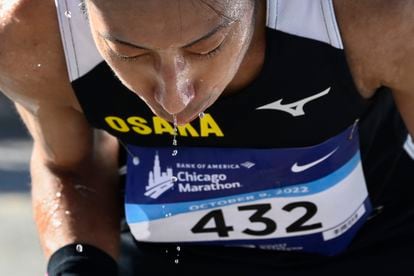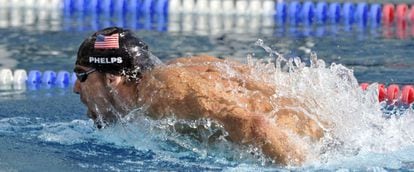How to recover after a workout: Natural methods are as beneficial as supplements | Sports
In recent years, gyms have become something of a mini-market for sports nutrition products, with a corner dedicated to protein powders and bars, recovery shakes, and all manner of liquids that promise dramatic performance gains. The point is that, in terms of exertion, taking a yoga class isn’t the same as doing high-intensity interval training (HIIT) or cycling over a few mountain passes. They are completely different types of training and require different forms of recovery.
The question many people ask when working out in the gym or at a sport is whether or not it is necessary to take a processed and packaged recovery product. The answer is simple: no. Despite marketing claims for these products, carbohydrates, protein and other micronutrients can be replenished with regular food and drink. “In fact, I would prioritize natural foods and only add supplements when needed,” says sports nutritionist Andrea Ferrandis. A balanced diet is often better than a post-workout strategy, she adds: “The need to eat something specific after a workout depends on the intensity of the workout: if you’re doing a high-intensity 40-minute workout, you need a good recovery strategy; If you do a very low-intensity 90-minute bike ride, you probably don’t need it.” Frequency also matters: If you go to the gym five times a week, a recovery program can be useful. If you go once a week it’s not really necessary.
Once the necessity factor has been decided, the next question is what and how much? “The right thing to do post-workout is to eat carbs to replenish glycogen stores, along with protein to repair muscle,” says Ferrandis. “This should be in a 2:1 ratio: that is, for every two grams of carbs, we should add one gram of protein.” The famous recovery shakes that many athletes use already contain that exact proportion. But everyday foods can offer the same thing: rice with chicken or tuna, a plate of vegetables (or hummus), or a ham sandwich. “The most important thing is to factor that intake into your total calorie and macronutrient count. It’s not about eating a sandwich when you leave the gym and then a big dinner when you come home.”

The Metabolic Window
While it’s wise to replace carbs as soon as possible (they’re like putting gas in a car to keep it running), recent research suggests proteins can wait a little longer. This is related to what is known as the metabolic window – the period of time when the body can most efficiently absorb proteins. As this window closes, amino acids become less readily synthesized. Some experts place this window at up to two hours post-workout. Others limit the time window to 30-45 minutes. “Recent studies seem to indicate that protein can be taken several hours after or even before exercise. However, it is particularly beneficial to do this within the two hours before or after your workout to stimulate muscle recovery as quickly as possible,” says nutritionist and nutritionist Ramón de Cangas.
Chips are not the answer to sodium recovery
When we sweat, we lose electrolytes, primarily sodium. However, not everyone sweats in the same way and the sodium composition of the human body is also different. Exercise intensity has an impact, but there are other factors, including gender (men sweat more than women), age (sweat glands shrink with age), temperature and humidity, and even testosterone and cortisone levels. Sodium makes up 50% of a salt molecule, and as such, the simple spice is the prime contender when it comes to replacing electrolytes lost through sweat. In fact, legislation in Spain dictates that electrolyte drinks for athletes must contain between 460 and 1,150 mg/L of the mineral to be considered as such. These drinks don’t taste salty because they’re loaded with sugar in the form of glucose and sucrose to create a high glycemic response. Once one of these drinks has been consumed post-workout, “there’s no point in consuming it anymore,” says nutritionist and author Laura Jorge. “And even less eating a bag of chips or piling salt on top of the rest of your food on the excuse that you’re replacing electrolytes.”
There are homemade alternatives to electrolyte drinks. Nutritionist and nutritionist Virginia Gómez Sánchez provides one: two and a half tablespoons of sugar or honey, half a teaspoon of baking soda, the juice of two lemons or two oranges, and a pinch of salt dissolved in a liter of water.
Sugar is ok, but in small doses
As with salt, so with sugar: “Fast sugars like glucose are the best way to replenish glycogen stores post-workout. That is why fruit is not the best option in these cases. Fructose, the sugar naturally contained in fruit, is absorbed more slowly, partly because of the fruit’s own fiber. So, in this case, and without setting a precedent, taking pure sugar is entirely justified. We’re not talking about an excuse to eat cake, we’re talking about a glycogenic drink,” says Ferrandis.
During strenuous training, it is necessary to dose sugar so as not to hit the wall or experience extreme fatigue: Ferrandis, who specializes in creating diets for professional athletes, notes: “If the activity is between one and two and a half Hours you need to consume 30-60 grams of carbohydrates. For anything beyond this period, the dose is 90 grams per hour. There is no need to consume even one gram of sugar too much.”

If you’re not Michael Phelps, don’t try to eat like him
Post-workout intake should be administered in accordance with the individual’s specific energy needs. In general, we tend to overestimate the energy we burn during exercise and underestimate the regenerative power of food and drink. A person weighing 70 kilograms (154 pounds) burns about 600 calories in a one-hour spinning class. To think that we have to go all out on such an exercise to emulate Michael Phelps at the 2008 Olympics, where the American multiple gold medalist ate 12,000 calories a day, may lead to a far higher calorie intake being required. Hard training and weight gain happens more often than you think.